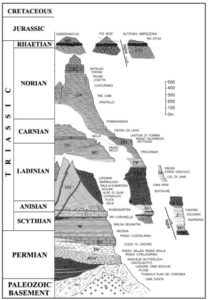Apr 17 2018
The Rise of the Dinosaurs
 It’s clear from the fossil record that at times in the history of Earth there have been massive and geologically rapid changes in the assemblage of life. For each such change, however, there is the question of what caused the change. Perhaps the most famous is the K-Pg extinction (Cretacious-Paleogene extinction) about 66 million years ago, known for the near extinction (except for birds) of perhaps the most iconic prehistoric clades, the dinosaurs.
It’s clear from the fossil record that at times in the history of Earth there have been massive and geologically rapid changes in the assemblage of life. For each such change, however, there is the question of what caused the change. Perhaps the most famous is the K-Pg extinction (Cretacious-Paleogene extinction) about 66 million years ago, known for the near extinction (except for birds) of perhaps the most iconic prehistoric clades, the dinosaurs.
Although there is still some legitimate debate about the relative contribution of various factors, the coup de grace for the non-avian dinosaurs appears to have been a large impact.
Mass extinctions, however, are not the only type of rapid change that needs explaining. There is also the rapid proliferation of new evolutionary groups. The two types of events may, mass extinctions and proliferation of new groups to dominance, may often be linked. It makes sense that a mass extinction will leave many unfilled niches to fill. They leave an evolutionary vacuum, and surviving species get sucked in, rapidly adapting to fill all the voids.
That does not mean, however, that all instances of new groups coming to dominance are in response to a recent mass extinction. There could be other causes, such as climate changes that do not result in mass extinction, or a tipping point in the ecosystem in which previously stable relationship are disrupted. Perhaps a group just hits upon a new ability or strategy that give it a significant advantage over competitors.
That is arguably what happened with humans. When our ancestors discovered fire and cooking, it enabled them to more efficiently extract nutrients from their food. This turned out to be a huge innovation, supporting larger brains and larger populations. With hunting and cooking, humans spread throughout the world, causing probably the greatest ecological disruption by one species in the history of the Earth.
The Rise of the Dinosaurs
As successful as we are, we are pikers compared to the dinosaurs. They roamed the Earth (interesting that they are always characterized as “roaming”) for almost 200 million years, spreading throughout the world. While it is now the dominant explanation that they were wiped out by a catastrophic event, it has been less clear why they proliferated in the first place.
A new study sheds some light on that question.
The dinosaurs first appear in the fossil record near the Permian-Triassic extinction event 253 million years ago. They remained rare, however, for another 20 million years before undergoing significant diversification. The question for the current study is – could the timing of the massive diversification of dinosaurs, when they took over the world, be dated more precisely, and therefore provide a clue as to the possible cause?
What the researchers did was review evidence not only from fossils but of dinosaur tracks from the, “exquisitely dated ichnofaunas of the Italian Dolomites.” The dolomites are limestone mountains in northern Italy that conveniently display stratigraphic layers in well-dated detail throughout the Permian and Triassic.
The short story is – layers in the Dolomite show no or very few dinosaur tracks, and then suddenly large numbers of dinosaur tracks. The sudden proliferation of dinosaur tracks is probably due to the sudden (within a million years or so) proliferation of dinosaurs. They compare this dating to the dating of dinosaur fossil proliferation, and the numbers agree well.
Dinosaur diversification and proliferation date to about 232 million years ago. This date is important because it correlates with another known event – the Carnian Pluvial Episode. This is another extinction event, thought to be caused by massive volcanic eruptions in what is now Canada, releasing large amounts of CO2, acidifying the ocean and causing global warming. The Carnian Pluvial Episode is characterized by a transition from arid to humid, and then back to arid again.
The rapid climate change cause an extinction event, and it now appears that dinosaurs survived and took advantage of the opening. They spread largely into niches left behind by now extinct herbivores.
So at least in this case, the explanation of why groups rapidly proliferate fits the standard model of filling vacant niches following an extinction.
And of course 166 million years later non-avian dinosaurs will suddenly exit the stage, leaving a massive vacuum that was filled ultimately by mammals, including one tiny branch of the primate order that now seems intent on causing its own climate change and mass extinction.






